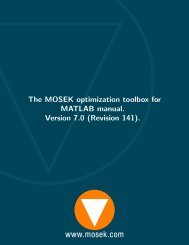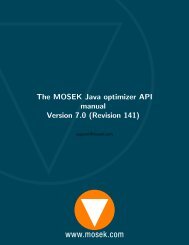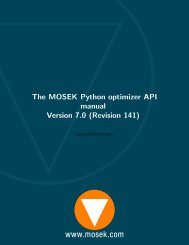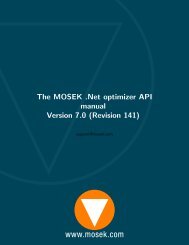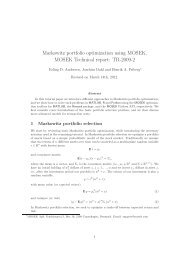The MOSEK command line tool Version 7.0 (Revision 141)
The MOSEK command line tool. Version 7.0 ... - Documentation
The MOSEK command line tool. Version 7.0 ... - Documentation
Create successful ePaper yourself
Turn your PDF publications into a flip-book with our unique Google optimized e-Paper software.
8.4. SENSITIVITY ANALYSIS FOR LINEAR PROBLEMS 73<br />
for which<br />
β ∈ [β 1 , β 2 ]<br />
f ′ l c i (β) = f ′ l c i (0).<br />
Since f l c<br />
i<br />
is not a smooth function f<br />
l ′ may not be defined at 0, as illustrated by the right example in<br />
i<br />
c<br />
figure 8.1. In this case we can define a left and a right shadow price and a left and a right <strong>line</strong>arity<br />
interval.<br />
<strong>The</strong> function f l c<br />
i<br />
considered only changes in li c . We can define similar functions for the remaining<br />
parameters of the z defined in (8.1) as well:<br />
f u c<br />
i<br />
(β) = z(l c , u c + βe i , l x , u x , c), i = 1, . . . , m,<br />
f l x<br />
j<br />
(β) = z(l c , u c , l x + βe j , u x , c), j = 1, . . . , n,<br />
f u x<br />
j<br />
(β) = z(l c , u c , l x , u x + βe j , c), j = 1, . . . , n,<br />
f cj (β) = z(l c , u c , l x , u x , c + βe j ), j = 1, . . . , n.<br />
Given these definitions it should be clear how <strong>line</strong>arity intervals and shadow prices are defined for the<br />
parameters u c i etc.<br />
8.4.1.1 Equality constraints<br />
In <strong>MOSEK</strong> a constraint can be specified as either an equality constraint or a ranged constraint. If<br />
constraint i is an equality constraint, we define the optimal value function for this as<br />
f e c<br />
i<br />
(β) = z(l c + βe i , u c + βe i , l x , u x , c)<br />
Thus for an equality constraint the upper and the lower bounds (which are equal) are perturbed<br />
simultaneously. <strong>The</strong>refore, <strong>MOSEK</strong> will handle sensitivity analysis differently for a ranged constraint<br />
with li c = uc i and for an equality constraint.<br />
8.4.2 <strong>The</strong> basis type sensitivity analysis<br />
<strong>The</strong> classical sensitivity analysis discussed in most textbooks about <strong>line</strong>ar optimization, e.g. [12], is<br />
based on an optimal basic solution or, equivalently, on an optimal basis. This method may produce<br />
misleading results [13] but is computationally cheap. <strong>The</strong>refore, and for historical reasons this<br />
method is available in <strong>MOSEK</strong> We will now briefly discuss the basis type sensitivity analysis. Given<br />
an optimal basic solution which provides a partition of variables into basic and non-basic variables, the<br />
basis type sensitivity analysis computes the <strong>line</strong>arity interval [β 1 , β 2 ] so that the basis remains optimal<br />
for the perturbed problem. A shadow price associated with the <strong>line</strong>arity interval is also computed.<br />
However, it is well-known that an optimal basic solution may not be unique and therefore the result<br />
depends on the optimal basic solution employed in the sensitivity analysis. This implies that the<br />
computed interval is only a subset of the largest interval for which the shadow price is constant.<br />
Furthermore, the optimal objective value function might have a breakpoint for β = 0. In this case the<br />
basis type sensitivity method will only provide a subset of either the left or the right <strong>line</strong>arity interval.



